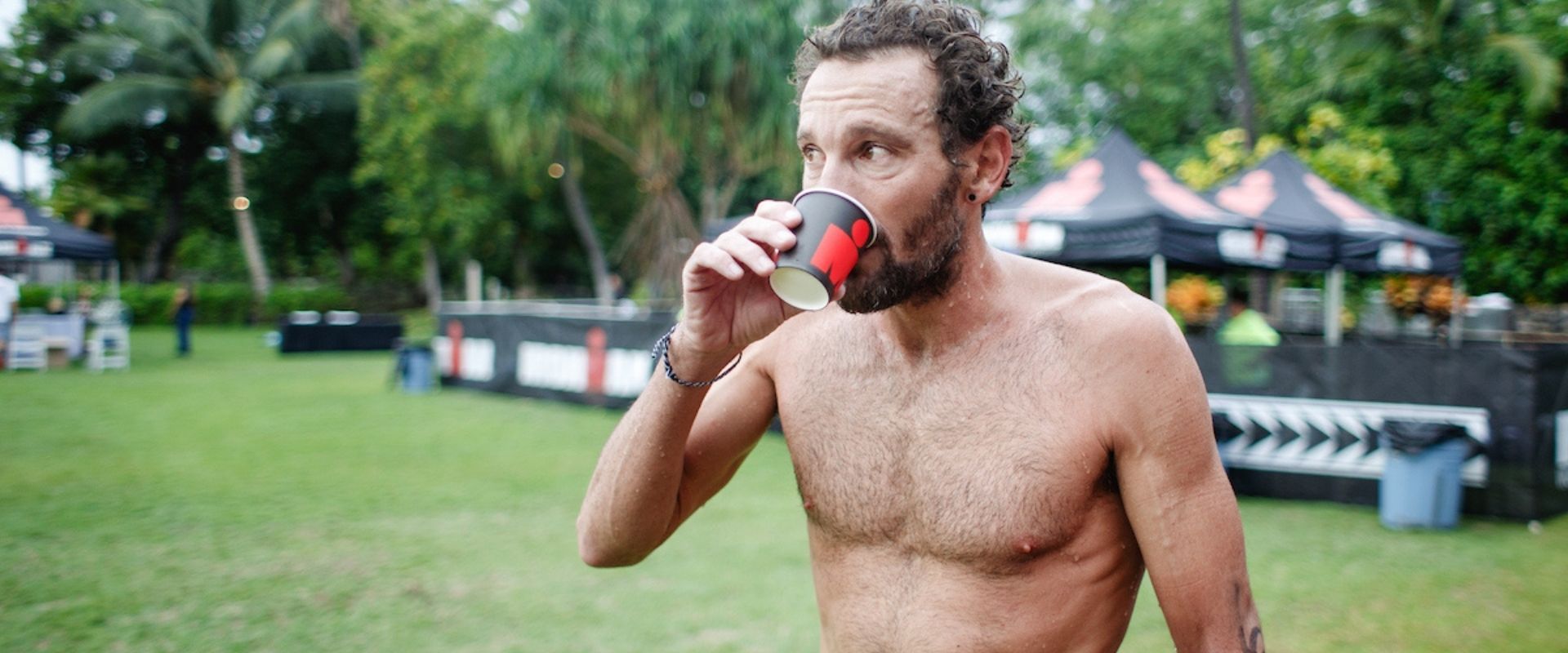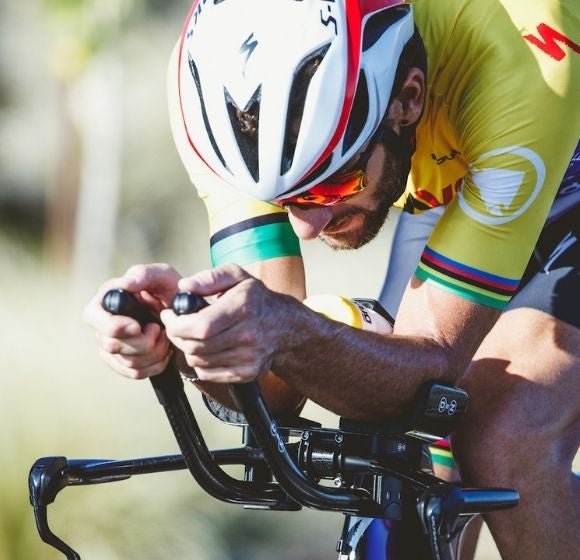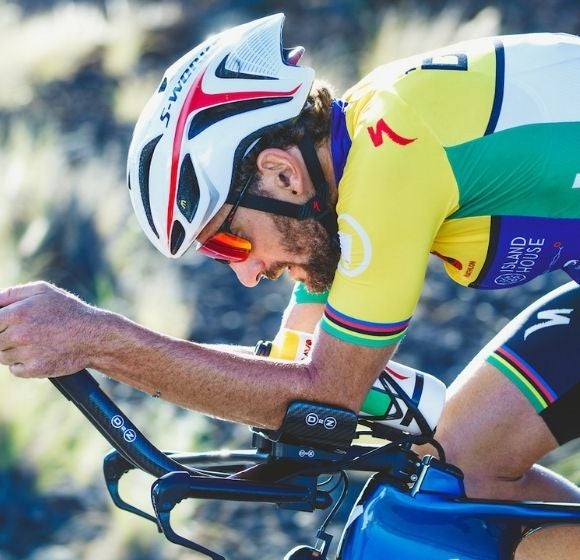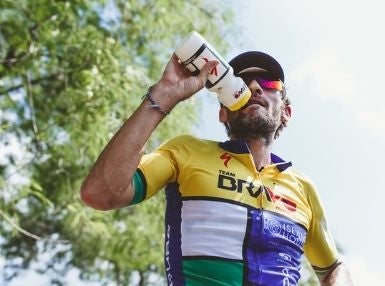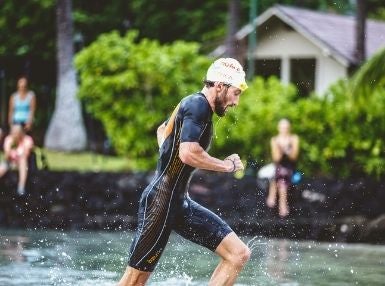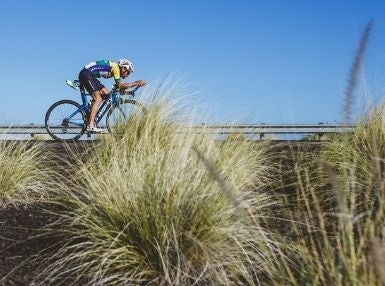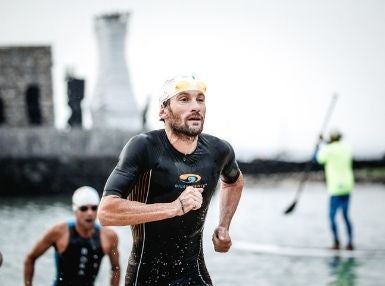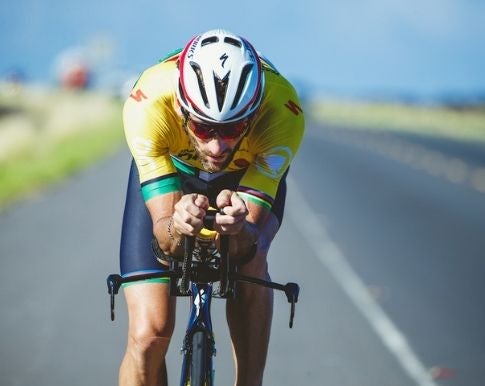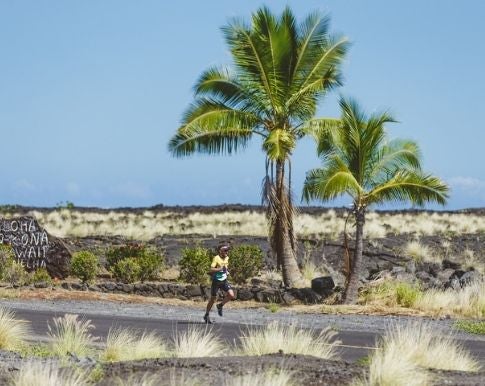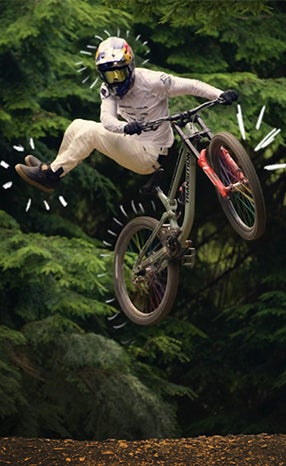TIME CHECK
Tim Don is the West London boy made good; the Brit now based in Boulder, Colorado, who wins triathlon’s most prestigious races and breaks world records.
If Don has come a long way from lifeguarding at an open air pool in Hampton, it’s a fact not lost upon him. Therein lies his charm. Don is not bewildered by his success - his accomplishments are the result of natural talent and years of effort - but he retains a self-deprecating humour that is classically British.
“I knew I’d run a 2:44 marathon, but I didn’t know about the Ironman record, until I turned around, saw the clock, and thought: ‘Gosh! Wow! Four minutes faster!’’’
When he discusses smashing the world record for an Ironman-sanctioned long-distance triathlon in Florianópolis, Brazil, earlier this year, there is nothing boastful in his assessment, despite the enormity of his achievement.
“To be honest, with about 13km to go, I saw some friends on the course, and one of them said: ‘You’re on for the record, if you can run a 2:48.’ And I was like: ‘Brilliant!’’’
He pauses for effect.
“What record?’”
Don’s telling of a story on which the rest of us might dine out for a lifetime - that of arguably his greatest accomplishment in a decorated career that has brought world titles and appearances at three Olympic Games - is modest, to say the least.
“I genuinely hadn’t realised they meant the world record,” he concludes, chuckling, and massively underplaying the astonishing feat of swimming for 2.4 miles, cycling for 112 miles and running a full marathon in a combined time of seven hours, forty minutes, and twenty-three seconds.
BOULDER 1-0 WIMBLEDON
Ask Don how he discovered triathlon and he will take you back to his lifeguarding days in Hampton, and the sight of Spencer Smith, arriving in a convertible Mercedes, removing a gleaming bicycle from the back seat, and casually announcing his plans to compete on the Côte d’Azur, or to winter in San Diego.
“And I’d think: ‘Blimey! I’ll be at the swimming pool and running cross-country on Wimbledon Common!’”. Cue an explosion of laughter.
“Florianópolis was the first time I felt I’d done justice to my run. It was not just physically demanding, but mentally, too. Except for the swim, I was out on my own for seven hours.”
Don clearly did not regard Smith’s lifestyle as an impossible dream, but he does not seem quite to have shaken the sense that his leading of it has involved a healthy dose of good fortune, despite the talent and determination. An example? He waxes lyrical on the delights of life in Boulder, but concludes that it is, “Blooming expensive!”.
The boy has done good - very good indeed - but one suspects that even as he prepares to start the Ironman world championships on Kona among the favourites for victory, Don will not forget those freezing races on Wimbledon Common. For mavericks like Endura, the appeal of his down-to-earth demeanour, and a modus operandi that combines hard graft with hard numbers, is obvious.
RECORD BREAKER
When we speak, Don is still having difficulty comprehending the scale of his achievement in breaking the world record for an ultra-distance triathlon in an Ironman-sanctioned event. Florianópolis is known as a fast course, but Don’s winning time of 7:40:23 was more than four minutes faster than Lionel Sanders’ previous record, and so fast by any standard.
Don says he knew he was in good shape in the lead up to the event. His training diary lacked what he describes as “legend sessions”, but provided evidence of something far more valuable: consistency. Even so, his race performance in Brazil surprised him.
“The suit is fast and comfortable, and constantly evolving. With Endura, it’s all about R&D and performance.”
The record books will preserve Don’s astonishing time, but fail to capture the sense of confusion in which it was achieved. Heavy cloud caused his GPS watch to behave erratically. One minute, to use his own words, he believed he was running faster than Mo Farah (more of whom later); the next, more slowly than his grandmother.
“People started shouting, ‘Come on! You’re really close. You can do it!’. I was thinking: ‘Really close? Does that mean I’m 10 seconds ahead? Or 10 seconds behind?’ It started to play tricks with my mind, so I didn’t let up, until I’d crossed the line.”
Still, as Don approached the finish, there was one further challenge to overcome: the giant clock that displays the athletes’ finishing times was pointed towards the media and not towards the competitors.
“When I crossed the finishing line, I didn’t know my time. I knew I’d run a 2:44 marathon, so unless people were telling porky pies, that was good enough. But I didn’t know about the Ironman record, until I turned around and thought: ‘Gosh! Wow! Four minutes.’”
Don’s glow of satisfaction washes across a Skype connection linking the United Kingdom with Boulder; a strange, but unmistakable phenomenon.
RUNNING MAN
Don first showed his athletic potential as a runner, and the run remains his strongest discipline. He grew up in West London, among a community of athletes who would go on to international success.
He cites St Mary’s University in Twickenham, where his parents studied and met, as a local beacon of success, with the presence of the national rugby stadium and the Harlequins and London Irish teams adding to a local tone in which excellence is the default setting. In addition, Teddington has long been a base for Kenyan athletes, who train in Bushy Park.
“I always say that an ITU race is like an ice pick to the leg; you’re just in pain for an hour and forty minutes. An Ironman race is like a dull toothache that doesn’t go away.”
Don says he is a strong believer in the phrase “excellence creates excellence”, but believes this extends to coaching and support, as well as the gifts of individual athletes. He reels of a list of local luminaries during his time in West London, including Sonia O’Sullivan, Ireland’s former 5,000m women’s world champion and Olympic silver medalist, and the Kenyan Daniel Komen, who still holds world records for the 3,000m, indoors and outdoors.
“I was lucky enough to be involved in high performance sport, without even knowing it,” Don says. “We were just going hammer-and-tongs, smashing ourselves to be the best. There was a guy called Mo in the run group that I trained with, who is obviously Mo Farah. I was the fourth or fifth fastest in the group, but that meant I was probably the fourth or fifth fastest in London. It was a great group.”
Don’s accomplishments as a runner stand comparison with any. Recorded times of 28 minutes for 10km, or eight minutes for the 3,000m, prove his pedigree. Until Florianópolis, however, he felt he had never come close to reaching his running potential during a triathlon. All of that changed in Brazil, where his time of 2:44:46, immediately after a gruelling 4:06:56 in the saddle, with no one for company, represented his best run to date in a triathlon.
“This was the first time I felt I’d myself justice as a runner. I ran a 2:44 off a very hard solo bike, which is not just physically demanding, but mentally too. Except for the swim, I was out on my own for seven hours.
“I couldn’t gauge my performance by other people, which I’d done in 70.3 events, or other Ironman events. If there’s someone ahead of you, you just hang on to them, or if they’re behind, you don’t want them to catch you. When I realised I had such a big lead, I had to work on a different mindset.”
STRATEGIC THINKER
Mindset has been critical to Don’s evolution as an ultra-distance competitor. He has moved through the distances as he has matured, much like a middle distance runner competing over steadily increasing distances and, in the case of Farah, entering the final phase of his career by moving from track to road.
Don represented Great Britain at three Olympic Games, from 2000 to 2008, and was world ITU champion in 2006. He admits that his instinct is to attack, and has won three 70.3 distance events this season alone, but says he has learned to play the long game as an ultra-distance competitor. His method has been “focussing on the small things, turning inwards and controlling myself, and to a degree focussing on my performance, rather than the result.”
“People were shouting, ‘Come on! You’re really close!’. I was thinking: ‘Does that mean I’m 10 seconds ahead? Or 10 seconds behind?’ It started to play tricks with my mind.”
All of which leads us to an aspect of ultra-distance triathlon which is rarely appreciated: that it is a chess match, as well as a physical challenge almost without comparison. Don waxes lyrical when I ask him to describe the strategic element of a sporting competition that lasts nearly eight hours.
He describes a host of details, from the importance of positioning during the swim (close to the front, but not too close to the swimmers ahead), adhering rigidly to a hydration and nutrition plan during the bike split, and taking note of a host of visual cues during the run, from roadside markers to GPS data.
This is a world away from Olympic distance racing, where the goal is to keep a close watch on your closest competitors, to respond when they attack, and to attack them in turn during moments of perceived weakness. Don has learned to hold back; to adjust to the mental and strategic battle played out over nearly eight hours in an Ironman triathlon.
“I always say that an ITU race is like an ice pick to the leg; you’re just in pain for 1:40. An Ironman race is like a dull toothache that doesn’t go away,” he says. “If you hear ‘eight minutes down’ during a split in an ITU race, you might as well be in a different post code. It really is game over. With Ironman, you just never know.
“In a short course event, you have to live in the moment. You really have to think fast. In Ironman, if someone overtakes me, my reaction is ‘Go! Go!’ but four hours, five hours, six hours later, that response could bite you on the bum. It was almost a case of taking a step back, having confidence in my training, in my own race; really turning inwards and focussing on what I can do, and controlling what I can control.”
HISTORY MAKER
Don’s history within triathlon closely mirrors the development of the modern sport; a discipline he now describes as mainstream. The days of explaining having to explain to casual observers that there is no horse riding involved in triathlon are over.
’Twas not ever thus. Don was an early adopter. The ITU was founded in 1989, and Don’s chance meeting with Smith, we have discussed. Critically, Don recognised that he had the required skillset. A strong runner, a keen swimmer, and a mountain biker who would ride in the Surrey Hills, he had the disciplines covered.
“There was a guy called Mo in my run group, who is obviously Mo Farah. I was the fourth or fifth fastest, which meant I was probably fourth or fifth fastest in London.”
Keen to follow in Smith’s footsteps, Don acquired a road bike, and in his fifth race in a fast-evolving sport, impressed selectors sufficiently to earn a place at the European championships in Finland, where he finished fourth. “I thought: ‘Wow! This is fantastic!’”.
He was just getting started: in 1998, Don was crowned world junior champion, and two years after that, he competed at the Olympic Games in Sydney. Triathlon’s Olympic debut coincided with his own. Truly, Don’s experiences can be considered a barometer for the entire sport.
He describes modern ITU as an increasingly specialist discipline; one in which it’s now necessary to be a ‘gun’ swimmer, and to come out of the water within 30 or 40 seconds of the leaders.
At the same time, ultra-distance competitors are becoming younger. A new group of athletes, aged in their early twenties, are starting their triathlon careers with 70.3 or full Ironman events. The young guns have speed, even if they lack experience. Don is sanguine. He says that he no longer has speed (although his competitors, especially those in Florianópolis, might disagree) but has experience to rival any.
“There are definitely two paths,” he says, drawing a parallel with marathon running’s new, youthful cohort. “I took the more traditional path, and I think that’s made me the athlete I am today, with the experience and all of those miles in my legs. I’ve been there, done that [ITU], and now I’m very happy, but I definitely wouldn’t be here now, if I hadn’t.”
THE ENDURA CONNECTION
Don leaves no stone unturned in his pursuit of success, having trained all his life with world class athletes, even when many were unknown. Don’s emergence among the best in his field is neatly paralleled by the success of former training partner Farah.
He admires Endura and cherishes their willingness to listen to his feedback. When he signed on with the Livingston brand, the QDC tri suit, now the sport’s dominant garment, used by Don, Nils Frommhold and Joe Skipper to record sub eight-hour times for ultra-distance triathlons, was still in development.
“I was lucky enough to be involved in high performance sport, without even knowing it. We were just going hammer-and-tongs, smashing ourselves to be the best.”
“They were still developing materials; still looking at fabrics,” he recalls. “So it’s been great to help them develop the kit. If you look at the suit today, I suggested putting a gel pocket on the back of the legs, and they listened to that. Also - and I’ve never had this before from an apparel sponsor - my kit is custom made.”
He talks in detail about the competing demands a manufacturer must balance to create a high-performance tri suit. The swim requires the athlete to open the chest; the aerodynamic demands of the bike split demands a ‘narrow’ frontal position. Optimise the suit entirely for aerodynamics, however, and the competitor inside it will leave the bike with a stiff back and not be able to run.
“So, yeah, the suit is fast and comfortable and constantly being developed,” he concludes. “With Endura, it’s all about R&D and performance; for example, the pad in the tri suit repels water, rather than soaking it up, so when you run, you don’t feel as if you’re wearing a nappy. They think holistically, which is great.”
FROM HAMPTON TO KONA
As ever, there is a mutual admiration between those in Livingston who design, develop and manufacture the kit, and the athletes, often thousands of miles away, who wear it to greatest effect.
For Pamela Barclay, Endura’s Brand Director, Don’s ability to extract the maximum from his potential, to combine a scientific approach with a ferocious work ethic, has obvious parallels with the modus operandi in Livingston.
“If you hear ‘eight minutes down’ during a split in an ITU race, you might as well be in a different post code. It really is game over. With Ironman, you just never know.”
“It goes without saying that Tim will seek every advantage from his clothing, as well as from his training, and it speaks volumes that having experienced the advantages of our QDC technology, he has teamed up with Matt Bottrill, a leading member of our time-trial tribe, to optimise his performance in the bike split.
“What is most impressive about Tim, however, is his attitude. At Endura, we don’t stand on ceremony, whether we’re scanning Movistar Team’s Nairo Quintana to create a life-sized body double and digital garment patterns, or working with Simon Smart in the Mercedes-AMG Petronas F1 wind tunnel. Tim’s approach means that he is very much one of the clan.”
Kona is now calling Don more intently than ever. He admits that Hawaii and its unforgiving conditions are always at the back of his mind; the driver for an holistic approach built on confidence - in himself, his coaches, and his equipment. His record-breaking performance in Florianópolis will have provided the ultimate fuel.
“If I race exactly the same as a I did in Brazil - obviously I won’t be going that fast, because it’s a different course, and it will be very hot, very windy - but if I have that sort of performance, I’m going to be fighting for a podium, absolutely. I have to go in there believing that, which I do,” he explains.
His tone is becoming serious, and justifiably so - racing on Kona for more than seven-and-a-half hours is a serious business - but it’s at precisely this point in our conversation that Don’s humour resurfaces.
“Hydration and nutrition are so important, because it’s 30 degrees with about 80 per cent humidity and howling winds,” he says, suitably serious. Then a pause, followed by the punchline.
“It really is great fun.”
FOOTNOTES Words by Timothy John. Images by BrakeThrough Media Kona, HI, United States©2021ENDURA
